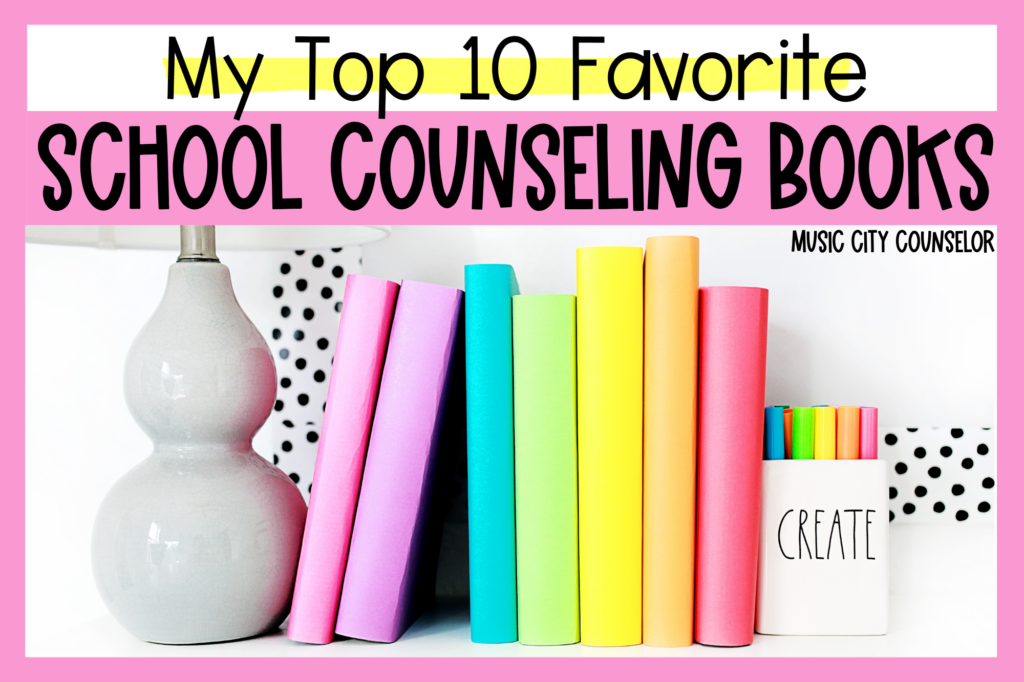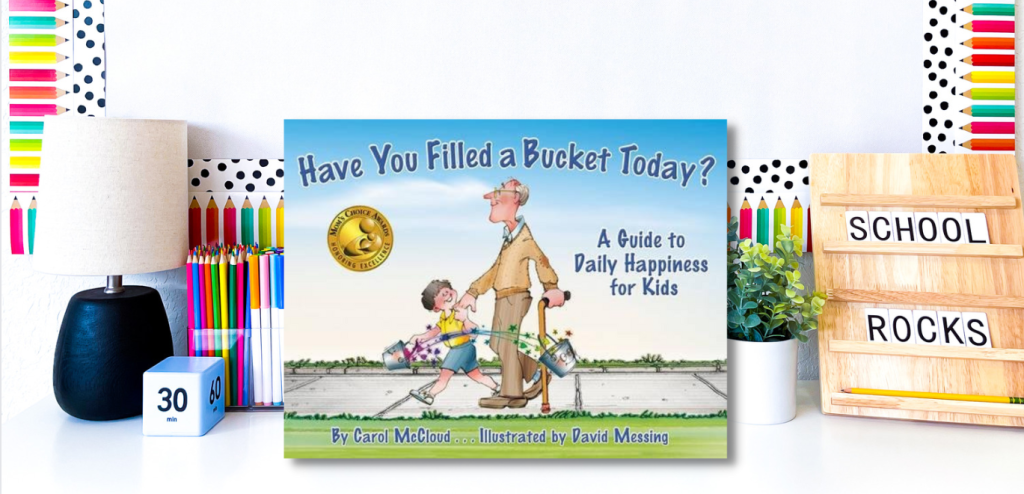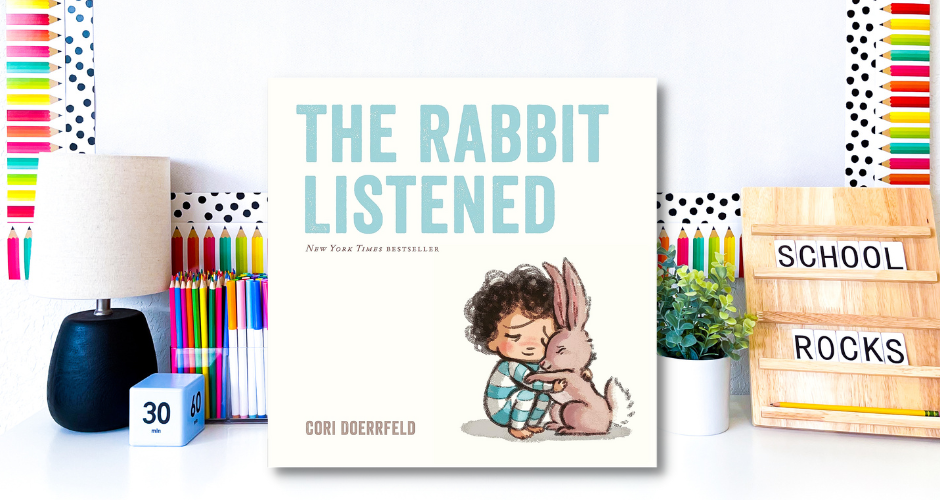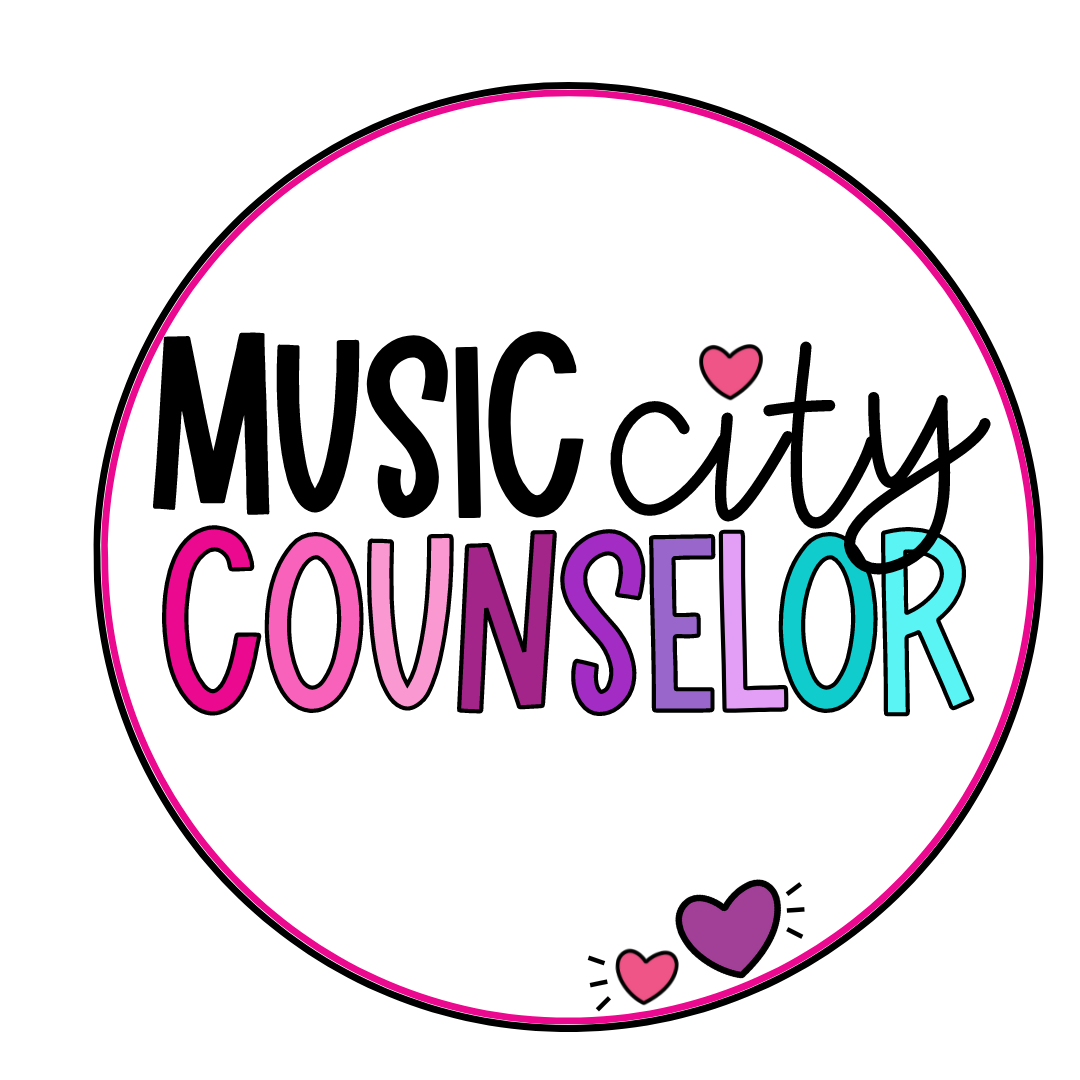
One of the most common questions that followers ask me is, “What are your favorite, must-have books for school counseling?”
Well, the truth is, I have SO MANY favorites that it’s hard to narrow down and make a list! Having a thorough school counselor library with books on a variety of topics is crucial to my success.
I make sure to have at least a couple of go-to books on as many SEL and mental health topics as possible (i.e. divorce, grief, anger, anxiety, etc.) so I am ready for any student needs that walk through my door (and can easily prep for classroom lessons, too!).
Read on to learn more about my top 10 favorite books for school counseling!

“Have You Filled a Bucket Today?” by Carol McCloud

“Have You Filled A Bucket Today?” by Carol McCloud is the one story I use every.single.year with my students…and often revist mid-year as well (Amazon Affiliate Link).
It is a memorable and heartwarming story that beautifully conveys the power of kindness and empathy. The concept of “filling someone’s bucket” (or “dipping” out of it) is so easy for students to grasp and really sticks with them. Students learn that even the simplest acts of kindness, like saying kind words, offering a helping hand, or simply showing empathy, can make a big difference in someone’s day.
I love using this story at the beginning of the year to encourage a positive and inclusive school climate, and revisiting it mid-year to review social skills and behavioral expectations.
For fun and interactive activities to go along with the story, be sure to check out my companion lesson!
“The Invisible String” by Patrice Karst

“The Invisible String” by Patrice Karst is probably the most popular grief and loss story for elementary students – for good reason (Amazon Affiliate link)! Its powerful message sticks with us and offers a special and meaningful sense of togetherness with the loved one that we lost.
The story explains that all of us are connected by an invisible string of love. When we miss someone, they feel a tug on the invisible string, and know that we are thinking of them and loving them from afar. Our invisible strings can connect us to mom and dad while we’re at school, to grandma who lives in another state, to our loved ones in heaven, and to anyone and everyone in between.
No matter what, our invisible strings can never be broken.
This story is so touching and beautiful and helps children remember that their loved ones are never truly gone, but instead are with them in their hearts wherever they go.
To further support your students, you can use my grief and loss journal that goes along with this story.
“The Rabbit Listened” by Cori Doerrfeld

You’ve probably noticed that there are very few story books out there that teach about the role of the school counselor. It took me a few tries to find a great one! My most favorite story for my introduction lessons is “The Rabbit Listened” by Cori Doerrfeld (Amazon Affiliate Link).
The rabbit is a beautiful and memorable representation of the school counselor. Just like the rabbit, school counselors listen, love, help, support, care, and stay by your side. Although the rabbit concept is metaphorical, it is so easy for all students to comprehend.
When one of my students called out, “You’re the rabbit! It’s you!” I knew I had found a winner.
This story can also be a beautiful introduction to listening skills, friendship, and kindness.
“When Miles Got Mad” by Abbie Schiller & Samantha Counter

“When Miles Got Mad” by Abbie Schiller and Samantha Counter is my absolute favorite, go-to story for helping children manage anger (Amazon Affiliate Link). Its focus on sibling conflict is instantly relatable for kids and concept of the “mad monster” is so memorable and engaging!
It tells the story of Miles and his little brother Max. Like all little brothers, Max loves playing with his big brother’s toys. Miles tries his best to be patient and understanding with little Max, until one day when Max breaks his special new model airplane that he built with his dad. When the plane breaks, Miles quickly becomes very angry and when he looks at his reflection in the mirror, he is astonished to see a mad monster looking back at him! Miles learns that the angrier he becomes, the bigger and bigger the mad monster grows.
But, when Miles starts using his words to express his feelings about the airplane, amazingly, the mad monster starts to shrink!
Talking out his feelings causes the mad monster to get smaller and smaller, until Miles is calm enough to begin fixing the plane.
I love using my companion lesson to review the story and teach students meaningful coping skills to manage their anger.
“The Recess Queen” by Alexis O’Neill

I’ve read “The Recess Queen” by Alexis O’Neill aloud so many times (and it’s so adorably catchy) that I literally have it memorized (Amazon Affiliate Link).
It tells the story of a little girl named Jean, who rightfully earned the title of the “Recess Queen.” She is the bossy ruler of the playground who always gets to be first and gives anyone a piece of her mind who tries to stand in her way. Until one day, when a new friend named Katie Sue comes to school. She was a small, quiet child – until it was time for recess. Katie Sue was the first friend brave enough to stand up to Jean! And not only did she stand up to the Recess Queen, she even asked her to play!
Katie Sue changed Jean’s heart that day, and from then on, the playground became a much happier place to be.
I love how our unlikely hero little Katie Sue was able to singlehandedly inspire change in her peers. She realized that, just like everyone else, Jean just wanted to be included, and her small act of kindness changed the whole dynamic of their playground!
To reinforce these concepts with your students, I recommend using my companion lesson!
“A Terrible Thing Happened” by Margaret H. Holmes

“A Terrible Thing Happened” by Margaret H. Holmes is absolutely unmatched when it comes to supporting students with trauma (Amazon Affiliate Link).
A little raccoon named Sherman Smith witnessed the most terrible thing. He tried to forget about it and hide it, but it started to bother him. He felt nervous for (seemingly) no reason, his stomach hurt, and he had bad dreams. He felt angry, which caused him to make bad choices and get into trouble. Until he met Ms. Maple, his counselor, and she helped him talk through the terrible thing. Ms. Maple helped Sherman heal, process his feelings and experiences, and feel much better.
What’s amazing about this story is that the “terrible thing” Sherman experienced is purposely ambiguous so it can apply to ANY trauma a child is going through.
The picture shown on the cover of the “terrible thing” is blurred so that the child can interpret it as they please. I love asking them to explain what they see in the image, guess what Sherman’s “terrible thing” might be, and when they’re ready, share theirs’. I also appreciate how the story encourages children to follow Sherman’s example and go to a safe, trusted adult for support, guidance, and love. This story is so relatable and gently told, so it is perfect for starting and introducing tough topics and conversations in classroom lessons, small groups, and with individuals.
“The Invisible Boy” by Trudy Ludwig

If you haven’t read “The Invisible Boy” by Trudy Ludwig, I suggest adding it to your cart right now (it’s that good!) (Amazon Affiliate Link).
“The Invisible Boy” tells the story of a little boy named Brian, who feels unnoticed by his peers. In the classroom, the teacher is busy with other, more boisterous students. At recess, the kids play without him. And in the cafeteria, he hears about special birthday parties that he wasn’t invited to.
Until one day, when a new student named Justin joins their class. Justin quickly becomes the target of mean words and giggles, and Brian decides to cheer him up by writing a kind note to his new friend. Brian’s act of kindness means a lot to Justin, who then starts to include Brian in his group work in the classroom and at the table at lunch. For once in his life, Brian finally feels seen, valued, and loved.
It only took one special and brave soul to completely change Brian’s world for the better.
Looking for a lesson to go along with this amazing story? The lesson that I created teaches students all about the power of kindness and inclusion. They learn that small things like asking someone to play, inviting someone to sit with them at lunch, or asking someone to join their group can have a huge, lasting impact.
“Worry Says What” by Allison Edwards

My go-to story for supporting students with anxiety is “Worry Says What” by Allison Edwards (Amazon Affiliate Link).
It tells the story of a Worry Monster who likes to “set up camp” inside of a little girl’s brain.
When he’s around, the little girl doubts herself and stresses about just about every part of her life. Until one day, when she decides to make a change and not let the Worry Monster control her thoughts and feelings anymore. As she grows stronger and thinks calm thoughts, the Worry Monster’s voice gets quieter and quieter, until he starts to pack up his tent and leave. And no need to worry, because the little girl is ready with a new mindset and set of skills for the next time he shows up!
If you’re needing a companion lesson to go along with this story, please check out the one I created and use!
“Clark the Shark” by Bruce Hale

I felt like I struck gold the first time I read “Clark the Shark” by Bruce Hale (Amazon Affiliate Link).
Clark is a silly and lovable shark who struggles with self-control. His energy and exuberance often lead to unintentional mishaps and conflicts with his friends, and trouble at school. His goofy antics draw students in and make for meaningful teachable moments about making good choices, being considerate of others, and controlling our thoughts, words, and actions.
I love using this story in classroom lessons, small groups, and with individual students. The companion lesson that I created is perfect for teaching students how to “cool their jets” just like Clark learned to do in the story!
“One” by Kathryn Otoshi

Have you been wanting to teach your students how to be upstanders, but aren’t sure where to start? Try the story “One” by Kathryn Otoshi (Amazon Affiliate Link).
It tells the story of Blue. Blue likes who he is, except when he is around Red. Red picks on Blue, calls him names, and makes him feel like he just isn’t good enough. The other colors don’t like what they see, and comfort Blue – as long as Red isn’t around. But, their silence in front of Red gives Red even more power. Thankfully, everything changes when a hero named One arrives. He teaches all of the colors how to “count” and be “the one” to stop bullying. One even chooses to include and be kind to Red because he believes that each and every one of us have value!
This story hooks students’ attention and teaches them a powerful lesson: it only takes ONE voice to ignite change and stand up to bullying! To reinforce these important concepts with your students, try my companion lesson!
I hope this post offered you a helpful start to building your school counselor library!
Have you used any of these books with your students? What are your favorite books for school counseling? Please comment below, I’d love to hear from you!

You may also be interested in:


Leave a Reply